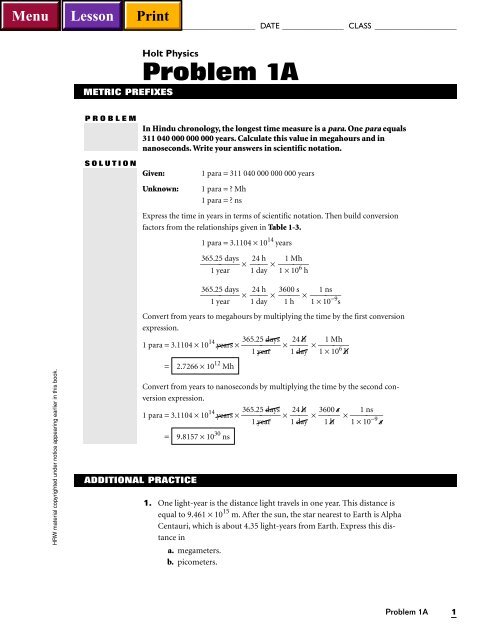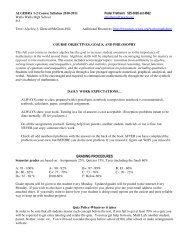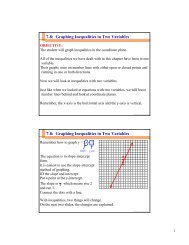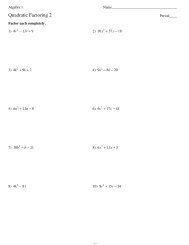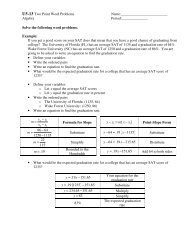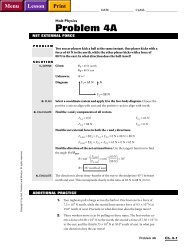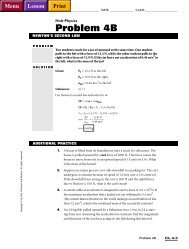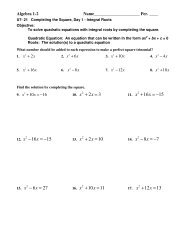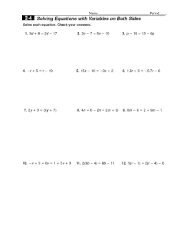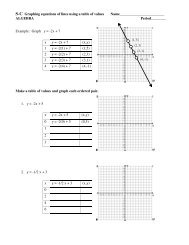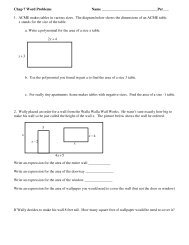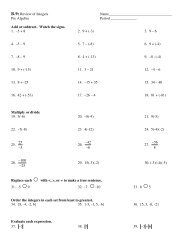Problem 1A
Problem 1A
Problem 1A
Create successful ePaper yourself
Turn your PDF publications into a flip-book with our unique Google optimized e-Paper software.
NAME ______________________________________ DATE _______________ CLASS ____________________<br />
Holt Physics<br />
<strong>Problem</strong> <strong>1A</strong><br />
METRIC PREFIXES<br />
PROBLEM<br />
SOLUTION<br />
In Hindu chronology, the longest time measure is a para. One para equals<br />
311 040 000 000 000 years. Calculate this value in megahours and in<br />
nanoseconds. Write your answers in scientific notation.<br />
Given:<br />
Unknown:<br />
1 para = 311 040 000 000 000 years<br />
1 para = ? Mh<br />
1 para = ? ns<br />
Express the time in years in terms of scientific notation. Then build conversion<br />
factors from the relationships given in Table 1-3.<br />
1 para = 3.1104 × 10 14 years<br />
365.25<br />
days<br />
24 h 1Mh<br />
⎯⎯ × ⎯⎯ × ⎯⎯<br />
1 year<br />
1 day<br />
1 × 10 6 h<br />
HRW material copyrighted under notice appearing earlier in this book.<br />
ADDITIONAL PRACTICE<br />
365.25<br />
days<br />
24 h<br />
⎯⎯ × ⎯⎯ × ⎯ 36 00s<br />
1 ns<br />
⎯ × ⎯⎯<br />
1 year<br />
1 day<br />
1 h 1 × 10<br />
−9 s<br />
Convert from years to megahours by multiplying the time by the first conversion<br />
expression.<br />
1 para = 3.1104 × 10 14 years × ⎯ 365 .25<br />
days<br />
24 h 1Mh<br />
⎯ × ⎯⎯ × ⎯⎯<br />
1 year<br />
1 day<br />
1 × 10 6 h<br />
=<br />
2.7266 × 10 12 Mh<br />
Convert from years to nanoseconds by multiplying the time by the second conversion<br />
expression.<br />
1 para = 3.1104 × 10 14 years × ⎯ 365 .25<br />
days<br />
24 h<br />
⎯ × ⎯⎯ × ⎯ 36 00s<br />
1 ns<br />
⎯ × ⎯⎯<br />
1 year<br />
1 day<br />
1 h 1 × 10<br />
−9 s<br />
= 9.8157 × 10 30 ns<br />
1. One light-year is the distance light travels in one year. This distance is<br />
equal to 9.461 × 10 15 m. After the sun, the star nearest to Earth is Alpha<br />
Centauri, which is about 4.35 light-years from Earth. Express this distance<br />
in<br />
a. megameters.<br />
b. picometers.<br />
<strong>Problem</strong> <strong>1A</strong> 1
NAME ______________________________________ DATE _______________ CLASS ____________________<br />
2. It is estimated that the sun will exhaust all of its energy in about ten<br />
billion years. By that time, it will have radiated about 1.2 × 10 44 J (joules)<br />
of energy. Express this amount of energy in<br />
a. kilojoules.<br />
b. nanojoules.<br />
3. The smallest living organism discovered so far is called a mycoplasm. Its<br />
mass is estimated as 1.0 × 10 –16 g. Express this mass in<br />
a. petagrams.<br />
b. femtograms.<br />
c. attograms.<br />
4. The “extreme” prefixes that are officially recognized are yocto, which indicates<br />
a fraction equal to 10 –24 , and yotta, which indicates a factor equal<br />
to 10 24 . The maximum distance from Earth to the sun is 152 100 000 km.<br />
Using scientific notation, express this distance in<br />
a. yoctometers (ym).<br />
b. yottameters (Ym).<br />
5. In 1993, the total production of nuclear energy in the world was<br />
2.1 × 10 15 watt-hours, where a watt is equal to one joule (J) per second.<br />
Express this number in<br />
a. joules.<br />
b. gigajoules.<br />
6. In Einstein’s special theory of relativity, mass and energy are equivalent.<br />
An expression of this equivalence can be made in terms of electron volts<br />
(units of energy) and kilograms, with one electron volt (eV) being equal<br />
to 1.78 × 10 –36 kg. Using this ratio, express the mass of the heaviest<br />
mammal on earth, the blue whale, which has an average mass of<br />
1.90 × 10 5 kg, in<br />
a. mega electron volts.<br />
b. tera electron volts.<br />
7. The most massive star yet discovered in our galaxy is one of the stars<br />
in the Carina Nebula, which can be seen from Earth’s Southern<br />
Hemisphere and from the tropical latitudes of the Northern Hemisphere.<br />
The star, designated as Eta Carinae, is believed to be 200 times as massive<br />
as the sun, which has a mass of nearly 2 × 10 30 kg. Find the mass of Eta<br />
Carinae in<br />
a. milligrams.<br />
b. exagrams.<br />
8. The Pacific Ocean has a surface area of about 166 241 700 km 2 and an<br />
average depth of 3940 m. Estimate the volume of the Pacific Ocean in<br />
a. cubic centimeters.<br />
b. cubic millimeters.<br />
HRW material copyrighted under notice appearing earlier in this book.<br />
2<br />
Holt Physics <strong>Problem</strong> Workbook
The Science of Physics<br />
Chapter 1<br />
Additional Practice <strong>1A</strong><br />
Givens<br />
1. distance = 4.35 light years<br />
Solutions<br />
distance = 4.35 light years × ⎯ 9.4 15<br />
61<br />
× 10<br />
m<br />
⎯ = 4.12 × 10 16 m<br />
1 light<br />
year<br />
a. distance = 4.12 × 10 16 m × ⎯ 1 Mm<br />
10 6 ⎯ =<br />
m<br />
4.12 × 10 10 Mm<br />
b. distance = 4.12 × 10 16 pm<br />
m × ⎯⎯ 10<br />
1− 12 = 4.12 × 10 28 pm<br />
m<br />
2. energy = 1.2 × 10 44 J<br />
a. energy = 1.2 × 10 44 1 kJ<br />
J × ⎯⎯ 1 03<br />
= 1.2 × 10 41 kJ<br />
J<br />
b. energy = 1.2 × 10 44 1 nJ<br />
J × ⎯<br />
1 0 − ⎯<br />
9 = 1.2 × 10 53 nJ<br />
J<br />
II<br />
3. m = 1.0 × 10 −16 g<br />
a. m = 1.0 × 10 −16 1 Pg<br />
g × ⎯<br />
1 0 1 ⎯<br />
5 =<br />
g<br />
b. m = 1.0 × 10 −16 fg<br />
g × ⎯⎯ 10<br />
1−1 5 =<br />
g<br />
1.0 × 10 −31 Pg<br />
0.10 fg<br />
c. m = 1.0 × 10 −16 ag<br />
g × ⎯<br />
10<br />
1−⎯ 1 8 = 1.0 × 10 2 ag<br />
g<br />
Copyright © by Holt, Rinehart and Winston. All rights reserved.<br />
4. distance = 152 100 000 km<br />
a. distance = 152 100 000 km × ⎯ 1 000<br />
m 1 ym<br />
⎯ × ⎯⎯ 1 km<br />
10 −2<br />
4 = 1.521 × 10 35 ym<br />
m<br />
b. distance = 152 100 000 km × ⎯ 1 000<br />
m 1 Ym<br />
⎯ × ⎯<br />
1 km<br />
1 0 2 ⎯<br />
4 = 1.521 × 10 −13 Ym<br />
m<br />
5. energy = 2.1 × 10 15 W •h<br />
a. energy = 2.1 × 10 15 W •h × ⎯ 1 J/s<br />
⎯ × ⎯ 36 00s<br />
⎯ = 7.6 × 10 18 J<br />
1 W 1 h<br />
b. energy = 7.6 × 10 18 1 GJ<br />
J × ⎯⎯ 1 09<br />
= 7.6 × 10 9 GJ<br />
J<br />
6. m = 1.90 × 10 5 kg m = 1.90 × 10 5 1 eV<br />
kg × ⎯⎯ 1.78 × 10<br />
−36 = 1.07 × 10 41 eV<br />
kg<br />
a. m = 1.07 × 10 41 eV × ⎯ 1 MeV<br />
10 6 ⎯ = 1.07 × 10 35 MeV<br />
eV<br />
b. m = 1.07 × 10 41 1 TeV<br />
eV × ⎯<br />
1 0 1 ⎯<br />
2 = 1.07 × 10 29 TeV<br />
eV<br />
Section Two — <strong>Problem</strong> Workbook Solutions II Ch. 1–1
Givens<br />
Solutions<br />
7. m = (200)(2 × 10 30 kg) =<br />
4 × 10 32 kg a. m = 4 × 10 32 10 3 g 10 3 mg<br />
kg × × =<br />
1kg 1 g<br />
4 × 10 38 mg<br />
b. m = 4 × 10 32 kg × ⎯ 1 3<br />
0 g 1 Eg<br />
⎯ × ⎯<br />
1 kg<br />
1 0 1 ⎯<br />
8 = 4 × 10 17 Eg<br />
g<br />
8. area = 166 241 700 km 2<br />
depth = 3940 m<br />
V = volume = area × depth<br />
V = (166 241 700 km 2 )(3940 m) × <br />
⎯ 1 2<br />
000<br />
m<br />
⎯<br />
1 km<br />
<br />
V = 6.55 × 10 17 m 3<br />
a. V = 6.55 × 10 17 m 3 × ⎯ 10 6 3<br />
cm<br />
⎯<br />
1 m3<br />
= 6.55 × 10 23 cm 3<br />
b. V = 6.55 × 10 17 m 3 × ⎯ 10 9<br />
mm 3<br />
⎯<br />
1 m3<br />
= 6.55 × 10 26 mm 3<br />
II<br />
Copyright © by Holt, Rinehart and Winston. All rights reserved.<br />
II Ch. 1–2<br />
Holt Physics Solution Manual


